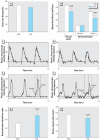Trichloroethylene exposure during cardiac valvuloseptal morphogenesis alters cushion formation and cardiac hemodynamics in the avian embryo
- PMID: 16759982
- PMCID: PMC1480523
- DOI: 10.1289/ehp.8781
Trichloroethylene exposure during cardiac valvuloseptal morphogenesis alters cushion formation and cardiac hemodynamics in the avian embryo
Abstract
It is controversial whether trichloroethylene (TCE) is a cardiac teratogen. We exposed chick embryos to 0, 0.4, 8, or 400 ppb TCE/egg during the period of cardiac valvuloseptal morphogenesis (2-3.3 days' incubation) . Embryo survival, valvuloseptal cellularity, and cardiac hemodynamics were evaluated at times thereafter. TCE at 8 and 400 ppb/egg reduced embryo survival to day 6.25 incubation by 40-50%. At day 4.25, increased proliferation and hypercellularity were observed within the atrioventricular and outflow tract primordia after 8 and 400 ppb TCE. Doppler ultrasound revealed that the dorsal aortic and atrioventricular blood flows were reduced by 23% and 30%, respectively, after exposure to 8 ppb TCE. Equimolar trichloroacetic acid (TCA) was more potent than TCE with respect to increasing mortality and causing valvuloseptal hypercellularity. These results independently confirm that TCE disrupts cardiac development of the chick embryo and identifies valvuloseptal development as a period of sensitivity. The hypercellular valvuloseptal profile is consistent with valvuloseptal heart defects associated with TCE exposure. This is the first report that TCA is a cardioteratogen for the chick and the first report that TCE exposure depresses cardiac function. Valvuloseptal hypercellularity may narrow the cardiac orifices, which reduces blood flow through the heart, thereby compromising cardiac output and contributing to increased mortality. The altered valvuloseptal formation and reduced hemodynamics seen here are consistent with such an outcome. Notably, these effects were observed at a TCE exposure (8 ppb) that is only slightly higher than the U.S. Environmental Protection Agency maximum containment level for drinking water (5 ppb) .
Figures






Similar articles
-
Cardiogenic effects of trichloroethylene and trichloroacetic acid following exposure during heart specification of avian development.Toxicol Sci. 2006 Nov;94(1):153-62. doi: 10.1093/toxsci/kfl083. Epub 2006 Aug 17. Toxicol Sci. 2006. PMID: 16917067
-
Altered cardiac function and ventricular septal defect in avian embryos exposed to low-dose trichloroethylene.Toxicol Sci. 2010 Feb;113(2):444-52. doi: 10.1093/toxsci/kfp269. Epub 2009 Nov 12. Toxicol Sci. 2010. PMID: 19910388 Free PMC article.
-
Trichloroethylene perturbs HNF4a expression and activity in the developing chick heart.Toxicol Lett. 2018 Mar 15;285:113-120. doi: 10.1016/j.toxlet.2017.12.027. Epub 2018 Jan 4. Toxicol Lett. 2018. PMID: 29306027 Free PMC article.
-
A review: trichloroethylene metabolites: potential cardiac teratogens.Environ Health Perspect. 1998 Aug;106 Suppl 4(Suppl 4):995-9. doi: 10.1289/ehp.98106s4995. Environ Health Perspect. 1998. PMID: 9703484 Free PMC article. Review.
-
Trichloroethylene cancer risk: simplified calculation of PBPK-based MCLs for cytotoxic end points.Regul Toxicol Pharmacol. 1997 Feb;25(1):26-42. doi: 10.1006/rtph.1996.1070. Regul Toxicol Pharmacol. 1997. PMID: 9056499 Review.
Cited by
-
Association between maternal exposure to housing renovation and offspring with congenital heart disease: a multi-hospital case-control study.Environ Health. 2013 Mar 25;12:25. doi: 10.1186/1476-069X-12-25. Environ Health. 2013. PMID: 23522351 Free PMC article.
-
Human health effects of trichloroethylene: key findings and scientific issues.Environ Health Perspect. 2013 Mar;121(3):303-11. doi: 10.1289/ehp.1205879. Epub 2012 Dec 18. Environ Health Perspect. 2013. PMID: 23249866 Free PMC article. Review.
-
Avian models in teratology and developmental toxicology.Methods Mol Biol. 2012;889:85-103. doi: 10.1007/978-1-61779-867-2_7. Methods Mol Biol. 2012. PMID: 22669661 Free PMC article. Review.
-
A systematic evaluation of the potential effects of trichloroethylene exposure on cardiac development.Reprod Toxicol. 2016 Oct;65:321-358. doi: 10.1016/j.reprotox.2016.08.014. Epub 2016 Aug 27. Reprod Toxicol. 2016. PMID: 27575429 Free PMC article. Review.
-
Risk factors of different congenital heart defects in Guangdong, China.Pediatr Res. 2016 Apr;79(4):549-58. doi: 10.1038/pr.2015.264. Epub 2015 Dec 17. Pediatr Res. 2016. PMID: 26679154
References
-
- Armstrong SR, Green LC. Chlorinated hydrocarbon solvents. Clin Occup Environ Med. 2004;4:481–496. - PubMed
-
- Bove FJ, Fulcomer MC, Klotz JB, Esmart J, Dufficy EM, Savrin JE. Public drinking water contamination and birth outcomes. Am J Epidemiol. 1995;141:850–862. - PubMed
-
- Boyer AS, Finch WT, Runyan RB. Trichloroethylene inhibits development of embryonic heart valve precursors in vitro. Toxicol Sci. 2000;53:109–117. - PubMed
-
- Broekhuizen ML, Mast F, Struijk PC, van der Bie W, Mulder PG, Gittenberger-de Groot AC, et al. Hemodynamic parameters of stage 20 to 35 chick embryo. Pediatr Res. 1993;34:44–46. - PubMed
-
- Campbell KA, Hu N, Clark EB, Keller BB. Analysis of dynamic atrial dimension and function during early cardiac development in the chick embryo. Ped Res. 1992;32:333–337. - PubMed
Publication types
MeSH terms
Substances
Grants and funding
LinkOut - more resources
Full Text Sources

